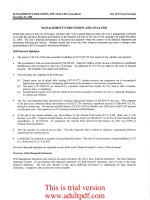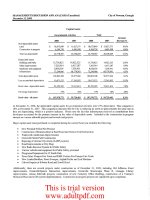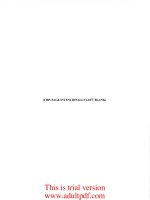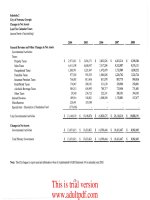Potential Uses of Environmental Impact Assessment Report for Environmental Dispute Resolution in Vietnam
Bạn đang xem bản rút gọn của tài liệu. Xem và tải ngay bản đầy đủ của tài liệu tại đây (167.05 KB, 10 trang )
VNU Journal of Science, Natural Sciences and Technology 28 (2012) 64-73
64
Potential Uses of Environmental Impact Assessment Report
for Environmental Dispute Resolution in Vietnam
Can Anh Tuan
1,
*, Hoang Xuan Co
2
, Nguyen Thi Hoang Lien
2
1
Department of Science, Technology and Environment, 1B Nguyen Tri Phuong, Hanoi, Vietnam
2
Faculty of Environmental Sciences, VNU University of Science, 334 Nguyen Trai, Hanoi, Vietnam
Received 27 February 2012
Abstract. Environmental Impact Assessment (EIA) is a mandatory legal procedure for investment
projects in Vietnam (the LEP 2005). EIA report is a base for authority agencies to make decision
on investment project approvement and a foundation for environmental management agencies to
control and inspect the implementation of legal regulations on project environmental protection.
Therefore, the results of EIA report are valuable not only in terms of science but also in terms of
law in environmental management and environmental dispute solutions relating to projects’
activities. However, in fact, environmental impact assessment in Vietnam still discloses
restrictions and does not reflect all its values as a project environmental management tool. This
article mentions the legal characters, ability, necessity and some sollutions to use the results of
project environmental impact assessment in the industrial production field in Vietnam as one of
scientific and legal bases in environmental dispute solution.
Keywords: Environmental Impact Assessment (EIA), Environmental Dispute, Law on
Environmental Protection (LEP).
1. Introduction
∗
∗∗
∗
In recent years, Vietnam is one of the
fastest growing nations in the world and has
achieved many accomplishments in socio-
economic development and poverty reduction
[1]. Average GDP growth rate in 2006-2010
period has reached 7%, which pushed Vietnam
one step further in the industrialization and
modernization promoting process. However,
together with the general growth of the
economy, urbanization and industrialization,
_______
∗
Corresponding author. Tel: 84-4-38435952.
E-mail:
Vietnam is facing many challenges due to
pollution, recession, environmental incidents,
natural resource exhaustion, biodiversity loss,
accompanied by claims about pollution and
environmental degradation consequences.
Environmental pollution in urban areas,
industrial zones, trade villages, river valleys all
over the country and other urgent
environmental issues have become hot matters
concerned by the whole society [2].
Together with policy priority given for
socio-economic development investment,
Vietnam government has very much focused on
the use of legal tools in combination with
C.A. Tuan et al. / VNU Journal of Science, Natural Sciences and Technology 28 (2012) 64-73
65
technical tools in environmental management.
Governments, international sponsors and non-
governmental organizations have confirmed
environmental impact assessment as a medium
and tool to control the impacts of economic
development over natural environment.
Considerable financial and human resources
have been put into environmental impact
assessment research and development in
Vietnam for the last decade [3].
Legal policies on environmental impact
assessment of socio-economic development
projects have appeared early in Vietnam. This
issue has been stipulated in Law in
Environment Protection 1993 [4]. Moreover,
environmental impact assessment regulations
on investment projects have been concretized in
Law in Environment Protection 2005 and the
implementation guiding text in terms of
content, form and quality requirements [5].
However, in reality, environmental impact
assessment in Vietnam need be investigated and
completed to be actually an efficient tool in
environmental management of investment
projects. Issues mentioned in this article
concentrate on legal position research, the
necessity to use results of industrial production
project environmental impact assessment in
Vietnam in environmental disputes through the
analysis of quality shortcomings and
restrictions of EIA reports. On this basis, we
put forward solutions to improve the quality of
EIA report results in order to use it as one of
scientific and legal bases in environmental
disputes.
2. Vietnam law and policies on EIA report
establishment
a) Project’s EIA report is a legal basis for
environmental management agencies to
approve project investment and implementation
Law on Environment Protection 2005 and
legal documents (Table 1) regulate that EIA
report establishment is carried out
simultaneously with investment project
establishment (feasibility study report). EIA
reports are assessed and approved by
environmental management agencies. Based on
the assessment results of EIA reports, authority
agencies can make decision on whether to ratify
projects or not. Or some work in the projects
must be regulated to satisfy the environmental
requirements [5].
Table 1. Legal documents stipulating legal position of environmental impact assessment
No Document name Content
1 Law on Environment Protection (LEP) on
November 29, 2005
Stipulates subjects to implement EIA; State agencies’
responsibilities in the EIA report assessement
2 Decree No. 29/2011/ND-CP on April 18,
2011 of the government on strategic
environmental assessment, environmental
impact assessment, environmental protection
commitments (Decree No.29 for short)
Stipulates detailed list of investment project categories
mandatory to be established EIA reports; basic content
of EIA reports, period for forming EIA reports in
investment project establishment process;
3 Circular No.26/2011/TT-BTNMT on July 18,
2011 of MONRE in detail some articles of
Decree No.29
Stipulates the process of EIA report assessment and
approval; structure, content detailed requirements and
form of EIA report.
C.A. Tuan et al. / VNU Journal of Science, Natural Sciences and Technology 28 (2012) 64-73
66
b) Approved project’s EIA report is a basis to
implement environmental management in the
project performance process
Project EIA report needs ensure the content
requirements according to regulations (Table 2).
When approved by State environmental
management agencies, EIA report is a basis for
environmental management agencies to
supervise and keep track of environmental
protection activities of projects such as waste
treatment, environmental protection method
implementation. Simultaneously, EIA report is
a basis for environmental management agencies
to supervise and solve environmental
complaints, denunciations and disputes in
project manager’s activities [5, 6].
Table 2. Requirements on EIA report content
No. Content requirements
1 Description about project origin (scale, work, etc)
2 Assessment methods, information and data source
3 General evaluation on the situation of project area and surrounding environment
4 Evaluation and forecast of project impacts on natural environment, community and relating socio-
economic elements
5 Public consultation in EIA report establishment process
6 Propose methods to minimize bad effects on natural environment, community health and socio-
economic elements
7 Work list, environmental issue management and supervision program in project implementation process
8 Construction cost estimate of environmental protection work in total estimated budget of the project
9 Project manager’s commitments on the implementation of environmental protection methods in the
construction and operation process of projects proposed in EIA report
[Source: Decree No.29/2011/NĐ-CP on April 18, 2011 of the government]
3. Using the results of project environmental
impact assessment as one of the bases to
solve environmental disputes
In environmental dispute resolution process,
the specification of subjects, scopes and
damage extent is of importance and a basis to
calculate indemnity levels [6]. Environmental
impact assessment is a tool enabling to solve
this issue because of the following reasons:
a) Environmental impact assessment allows to
define affected subjects leading to damage in
environmental dispute resolution
When carrying out environmental impact
assessment, project manager studies and
specifies subjects which can be affected by
project activities. Thus, affected subjects can be
soil, water, air, ecosystem, resources,
community health environments. These subjects
are defined based on scientific research results
and project implementation areas reality.
The fact that EIA report is approved means
that information and data on subjects affected
by project activities will be legalized. Thus, we
can specify damaged subjects in environmental
dispute resolution through information and data
on affected subjects determination results in
EIA report.
b) Environmental impact assessment allows to
determine the scope and severity of impact and
damage to the environment, resource and
community health in environmental dispute
resolution
In environmental impact assessment
process, the scope and severity of impact on the
C.A. Tuan et al. / VNU Journal of Science, Natural Sciences and Technology 28 (2012) 64-73
67
environment, resource and community health
due to project activities have been calculated
and defined. Environmental impact assessment
evaluation agencies base on characteristics,
nature and scale of waste and environmental
features in the area to give conclusion about the
severity and scope of environmental protection.
When EIA report is approved, the results of
impact scope and severity determination by
environmental pollution will be used as a basis
for specifying damage scope and severity in
environmental dispute resolution.
c) EIA defines the cost to perform
environmental protection methods in project
implementation process as a basis to calculate
damage indemnity cost in environmental
dispute resolution.
Environmental protection methods are put
forward on the basis of subject, scope and
impact extent study in EIA process. EIA
assessment and approval agencies base on the
feasibility of environmental protection methods
to decide the application according to the goal
of controlling, minimizing and treating
environmental pollution reaching national
technical standards and regulations on
environment.
In environmental protection methods
implementation process, the costs of these
issues will be calculated. Thus, we can base on
calculation data of environmental protection
methods implementation costs to work out
damage indemnity cost and carry out measures
to overcome consequences in environmental
dispute resolution process.
3. The situation of EIA establishment and
assessment in Vietnam
3.1. The situation of EIA report establishment
According to Decree No.29/2011/NĐ-CP
on April 18, 2011 of the government, subjects
which must set up EIA report belong to 19
project groups divided into 146 different kinds
of projects. EIA is an important legal and
technical tool to identify, analyze and forecast
projects’ environmental impact; provides
scientific ground for the government,
management agencies and enterprises to
consider while making decision about
investment [2, 4].
However, EIA activities in Vietnam still
expose many insufficiency and weaknesses
both of quality and implementation process
obedience. Through statistical survey results
among national level-approved 269 EIA reports
of projects in industrial production field in
2005-2009 period, we can summarize some
following comments:
a) EIA report establishment methods and
technique still have some drawbacks
Quantitative methods such as modeling,
cost-benefit analysis and map convolution ones
to specify impact scope are rarely used or used
as a procedure in EIA reports in Vietnam.
Statistical survey results among national
level-approved 269 EIA reports of projects in
industrial production field in the 2005-2009
period in Table 3 show that only 66.54% use
modeling method and software to calculate
pollution scope and level, the impact on water,
air, noise environments.
C.A. Tuan et al. / VNU Journal of Science, Natural Sciences and Technology 28 (2012) 64-73
68
Table 3. Statistics summary of methods and evaluation results of impact extent and severity in national level-
approved project EIA reports in industrial production field in the 2005-2009 period
Methods used in EIA/ The results of impact extent and severity specification
Methods: Data and
condition list, quick
evaluation
Methods: Direct field survey
and measurement
Methods: Modeling/
Calculation software
Qualitative results Quantitative results
No.
Assessment
time
No. of
assessed
EIA
Quantity Percentage Quantity Percentage Quantity Percentage
1 2005 28 28 100.00 28 100.00 12 42.86
2 2006 43 43 100.00 43 100.00 21 48.84
3 2007 65 65 100.00 65 100.00 34 52.31
4 2008 102 102 100.00 102 100.00 85 83.33
5 2009 31 31 100.00 31 100.00 27 87.10
Total 269 269 100.00 269 100.00 179 66.54
[Source: The authors total up and summarize among EIA assessment result documents of MONRE, 2011]
In recent years, some EIA reports have used
modeling method to evaluate environmental
impact level. However, the choice of model,
parameters and input data is still unsuitable and
short of scientific basis and trustworthiness.
b) The lack of information and input data for
EIA process
At present, we have not had the database of
consistent input data (waste, meteorology and
terrain data, natural environment data) to use
for models, software programs in order to
ensure the trustworthiness of air pollution
calculation results in Vietnam [3, 9].
Besides, environmental monitoring systems
have not been synchronized, equipments have
not been modernized, which creates difficulties
in providing input data for the model and
comparing, verifying between the results of
model calculations and actual measurements.
c) All influenced subjects, sensitivity level and
the load capacity of the environment have not
been specified
The fact in recent years shows that some
EIA reports have not identified all influenced
subjects because of subjective causes in
assessment process or objective causes due to
characteristics, complexity of environment and
the lack of ecosystem data and the information
about the load capacity of manufacturing
business area environment. This will create
difficulties in indentifying damaged subjects
and economic loss because of environmental
pollution.
d) Detailed extent and severity of impact on the
environment have not been specified
EIA reports in recent years show that the
specification of the extent and severity of
impact on the environment has not been clear
and detailed. Some EIA do not define or define
the impact on the environment and community
health in surrounding areas qualitatively. The
main reason is that data and information are
lacking or the suitable methods to quantify the
impact on environment have not been accessed
in assessment process.
C.A. Tuan et al. / VNU Journal of Science, Natural Sciences and Technology 28 (2012) 64-73
69
Statistical survey results among national
level-approved 269 EIA reports of projects in
industrial production field in the 2005-2009
period in Table 3 show that 100% of the reports
evaluate the extent and severity of the impact
on the environment qualitatively, only 66.54%
evaluate quantitatively.
e) The public consultation in EIA process is still
formal
The files of investigated EIA reports show
that opinions written in public consultation
documents are very general, require environmental
protection methods implementation according
to the regulations, and only state fund issue for
welfare and local labour acceptance activities.
Statistical survey results among national
level-approved 269 EIA reports of projects in
industrial production field in the 2005-2009
period in Table 4 show that 92.57% of the
reports reach the agreement of project
implementation location, 88.1% reach the
agreement of environmental protection
methods, 89.96% reach the agreement of
influenced subjects, 66.54% reach the
agreement of impact extent and severity.
Table 4. Statistics summary of public consultation situation in national level-approved project EIA reports
in industrial production field in 2005-2009 period
EIA with public consultation
Project
implementation
location
Environment
protection
methods
Impact subjects
Extent and
severity of
impact
No.
Assessment
time
No. of
assessed
EIA
Quantity Percentage Quantity Percentage Quantity Percentage Quantity Percentage
1 2005 28 25 89.29 23 82.14 23 82.14 12 42.86
2 2006 43 39 90.70 37 86.05 38 88.37 21 48.84
3 2007 65 61 93.85 59 90.77 62 95.38 34 52.31
4 2008 102 97 95.10 92 90.20 91 89.22 85 83.33
5 2009 31 27 87.10 26 83.87 28 90.32 27 87.10
Total 269 249 92.57 237 88.10 242 89.96 179 66.54
[Source: The authors total up and summarize among EIA assessment result documents of MONRE, 2011]
Consultation process has not reached the
unification of the specification of influenced
subjects, the extent and severity of impact on
the environment, ecosystem, community health
in surrounding areas or industrial
manufacturing bases. This leads to the
difficulties in agreement on the above issues
when environmental disputes occur and are
solved in manufacturing and business activities.
EIA report study shows that some
information and data can be used for
environmental dispute resolution. These data
include information about manufacturing and
business activities, waste and some impact on
resources and the environment. However, in
environmental dispute resolution process, some
results in EIA reports are still not specific and
detailed enough to be used. Some EIA reports
are of low quality, their figures are not
C.A. Tuan et al. / VNU Journal of Science, Natural Sciences and Technology 28 (2012) 64-73
70
objective, trustworthy and can not be a legal
and scientific base to be used in environmental
dispute resolution in Vietnam.
3.2. The situation of EIA report assessment
According to Law on Environment
Protection (Article 21), EIA report assessment
is carried out in the form of assessment board or
assessment service organizations. However, in
fact, the form of assessment board has been
applied more. Ministry of Natural Resources
and Environment organize EIA report
assessment board for projects approved by
National Assembly, the government, the prime
minister, interdisciplinary and interprovincial
projects, Ministry, ministerial and
governmental agencies organize EIA report
assessment board for projects of their approval
and decision authority, except interdisciplinary
and interprovincial ones; provincial people’s
committees organize the EIA report assessment
for projects in areas of their decision and
approval authority and of the same level
people’s councils [4].
On the basis of assessment board meeting
minutes, assessment reality in recent years still
has certain drawbacks. Some assessment
boards’ conclusions often state general rules
and some requirements for EIA report revision.
They do not make specific requests for
methods, contents, influenced subjects, the
extent and severity of impact quantitatively.
Besides, standing agencies of assessment
boards have not supervised closely and
specifically EIA report issue revision and
supplementation results based on the board’s
conclusions. Its reasons are the limit of the
assessment agency staff and assessment
specialists in quantity and quality; the lack of
machines and equipments to verify EIA report
results [4].
4. Solutions to improve the quality of EIA
report results for environmental dispute
resolution in Vietnam
As indicated above, EIA is a useful tool
used in environmental management and
environmental dispute resolution. However, in
order to perform this function, it is necessary to
apply some following EIA quality improvement
methods:
a) Better the EIA legal document system and
technical instruction for different kinds of
projects
EIA legal document system needs to be
improved towards mandatory use of methods,
calculation software to make quantitative
assessment of the scope and extent of
environment impacts in EIA process; EIA
report content adjustment to add all influenced
subjects which have not been evaluated at the
time of EIA report establishment, assessment
and approval due to objective reasons;
environmental technical standards and
regulations completion for EIA report
establishment and approval; sanctions for law
violations of EIA report establishment and
approval. Besides, there is a need to build and
better EIA technical instructions for specific
kinds of projects.
b) Build up national and industry database for
EIA report establishment and assessment
process
Information database for EIA report
establishment and assessment needs to be built
systematically. This database needs to have
C.A. Tuan et al. / VNU Journal of Science, Natural Sciences and Technology 28 (2012) 64-73
71
basic survey results, environmental monitoring,
meteorology, hydrology results, ecosystem and
biodiversity data, information about the waste
likely to cause environmental pollution, data on
polluted and degraded areas and environmental
problems, information about EIA methods,
tools and calculation software, results of
environmental damage indemnity solved by
authority state agencies and relating socio-
economic information [7]. The database needs
to be updated, controlled and used for EIA
establishment and approval.
c) Use trustworthy methods and software
programs to calculate pollution scope and
extent, map environmental impact partition in
EIA process
In EIA process, one important issue is to
specify the scope and extent of impact on
environment and surrounding community
health. Vietnamese legal system has regulations
of principle ensuring the human capacity and
equipment for EIA establishment consulting
organizations.
Besides, the usage of trustworthy methods
and evaluation tools is very meaningful for EIA
report quality. Particularly, with respect to
projects emitting dust, harmful air, wastewater,
it is a must to use trustworthy software
programs to calculate the scope and extent of
pollution, map the environmentally influenced
area partition at different levels in EIA process
[8].
d) Adjust the EIA report content to add
influenced subjects which have not been totally
evaluated at the time of EIA report
establishment and approval due to objective
reasons
The environment has complicated
characteristics and nature, its development
always changes. On the other hand, because of
objective causes, in EIA report establishment
and assessment process, all influenced subjects,
impact scope and extent can not be identified.
Therefore, EIA report content needs to be
adjusted regularly. This issue comes from EIA
argument nature which is an environmental
impact forecast and evaluation.
e) Carry out public consultation in EIA process
as an agreement method between project
manager and the public in the identification of
influenced subjects, the environmental impact
scope and extent
The public consultation in EIA report
establishment process is applied according to
Law on Environment Protection. Apart from the
agreement between the government and local
community on project implementation place,
environmental protection methods, welfare and
local labour acceptance activities, project
manager needs to negotiate to identify
influenced subjects, environmental impact
scope and extent through project’s EIA report
[9]. These are considered initial agreement
when environmental dispute has not occurred
yet. This will be useful and convenient when
environmental disputes in projects’ future
manufacturing and business activities are
solved.
f) Ensure the quality and efficiency of EIA
report assessment in both central and local
levels.
Ensure the staff resource in terms of both
quantity and quality for EIA state management
agencies system at the central and local level.
Invest in machines, equipments to verify EIA
report results. Ensure necessary fund for
activities before, during and after EIA
assessment. Ensure the legal liability
implementation of assessment board’s standing
C.A. Tuan et al. / VNU Journal of Science, Natural Sciences and Technology 28 (2012) 64-73
72
body in the close and detailed supervision of
EIA report’s issue supplementation and
correction results based on assessment board’s
conclusion.
5. Conclusion and recommendations
1. EIA is used as a useful tool in
environmental management of investment
projects thanks to its scientific and legal nature
and value. Moreover, the usage of EIA report
results to solve environmental disputes has
scientific and legal basis, and economize
financial and time costs as well. Thus, there is a
need for the regulations of EIA result usage in
environmental dispute resolution.
2. Carry out the argument and reality study
in environmental impact assessment. In
specific, focus on studying to use trustworthy
methods and software programs to calculate
pollution scope and extent, mapping
environmental impact partition in EIA process;
building up national and industrial database for
EIA report establishment and assessment.
3. Improve EIA legal system. Concentrate
on concretizing legal regulations towards
mandatory use calculation methods and
software tools to evaluate the scope and extent
of environmental impact quantitatively in EIA
process; EIA report content adjustment to add
influenced subjects which have not been totally
evaluated at the time of EIA report
establishment and assessment; improvement of
environmental technical standards and
regulations for EIA report establishment and
assessment; sanctions for violation of legal
regulations of EIA report establishment and
assessment.
Acknowledgements
Special thanks to Vietnam National
Foundation for Science and Technology
Development (NAFOSTED) for financial
support for authors to carry out the studies in
this article.
References
[1] World Bank, Taking stock: An update on
Vietnam's recent economic developments,
World Bank, 2009,
[2] Ministry of Natural Resources and
Environment, National environment report
2010- Vietnam environmental overview, Hanoi,
2010.
[3] Alison Clausen, Hoang Hoa Vu, Miguel
Pedrono, An evaluation of the environmental
impact assessment system in Vietnam: The gap
between theory and practice, Environmental
Impact Assessment Review 31 (2011), p.136-
143.
[4] Mai Thanh Dung, Environmental impact
assessment, strategic environmental assessment
and environmental protection commitment in
Vietnam at present. The proceedings of 3
th
conference on national environment in 2010,
Vietnam Environmental Administration, (2010),
p.478-486.
[5] Pham Ngoc Ho, Hoang Xuan Co,
Environmental impact assessment, Publishing
house of Hanoi National University, 2000.
[6] Alissa J. Stern, Using Environmental Impact
Assessment for Dispute Mangement,
Environmental Impact Assessment Review 11
(1991) p.81-87.
[7] Gordon Walker, Environmental justice, impact
assessment and the politics of knowledge: The
implications of assessing the social distribution
of environmental outcomes, Environmental
Impact Assessment Review 30 (2010) p.312-318.
[8] Noel de Nevers, Air pollution control engineering,
McGrew- Hill, Inc, New York, 1995.
[9] Obbard JP, Lai YC, Briffett C, Environmental
assessment in Vietnam: Theory and practice.
Journal Environmental Assessment Policy
Management 4 (2002), p.267-95.
C.A. Tuan et al. / VNU Journal of Science, Natural Sciences and Technology 28 (2012) 64-73
73
Khả năng sử dụng kết quả đánh giá tác động môi trường
để giải quyết tranh chấp môi trường ở Việt Nam
Cấn Anh Tuấn
1
, Hoàng Xuân Cơ
2
, Nguyễn Thị Hoàng Liên
2
1
Cục Khoa học, Công nghệ và Môi trường, số 1B Nguyễn Tri Phương, Ba Đình, Hà Nội, Việt Nam
2
Khoa Môi trường, Trường Đại học Khoa học Tự nhiên, ĐHQGHN, 334 Nguyễn Trãi, Hà Nội, Việt Nam
Đánh giá tác động môi trường (ĐTM) là một thủ tục pháp lý bắt buộc thực hiện đối với các dự án
đầu tư ở Việt Nam. Vấn đề này được quy định trong Luật Bảo vệ môi trường (BVMT) năm 2005. Báo
cáo ĐTM là căn cứ để cơ quan có thẩm quyền phê duyệt dự án, thanh tra, kiểm tra việc thực hiện các
quy định pháp luật về BVMT khi thực hiện dự án. Do vậy, kết quả trong báo cáo ĐTM không những
có giá trị về mặt khoa học mà còn có giá trị về mặt pháp lý trong quản lý môi trường và giải quyết các
tranh chấp môi trường liên quan đến hoạt động của dự án. Tuy nhiên, trong thực tế, công tác ĐTM ở
Việt Nam còn bộc lộ những hạn chế, bất cập, chưa phản ánh hết các giá trị như là công cụ quản lý môi
trường đối với dự án. Bài viết này đề cập đến giá trị pháp lý, khả năng, sự cần thiết và giải pháp sử
dụng kết quả ĐTM của dự án trong lĩnh vực sản xuất công nghiệp ở Việt Nam như là một trong những
căn cứ khoa học và pháp lý trong việc tranh chấp môi trường.









